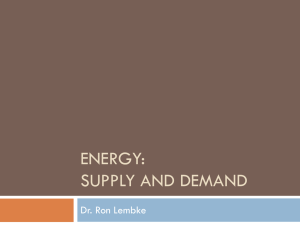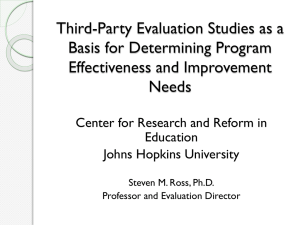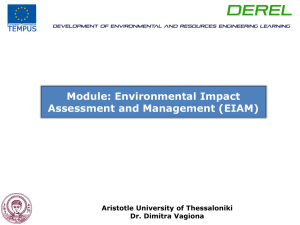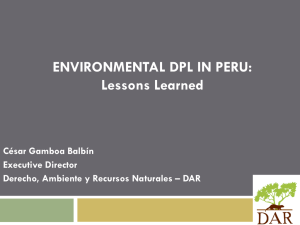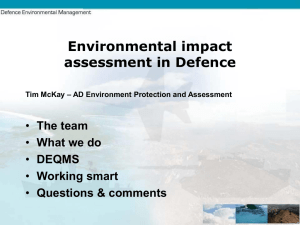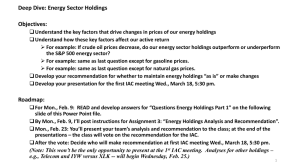EIA - Asian Judges Network on Environment
advertisement
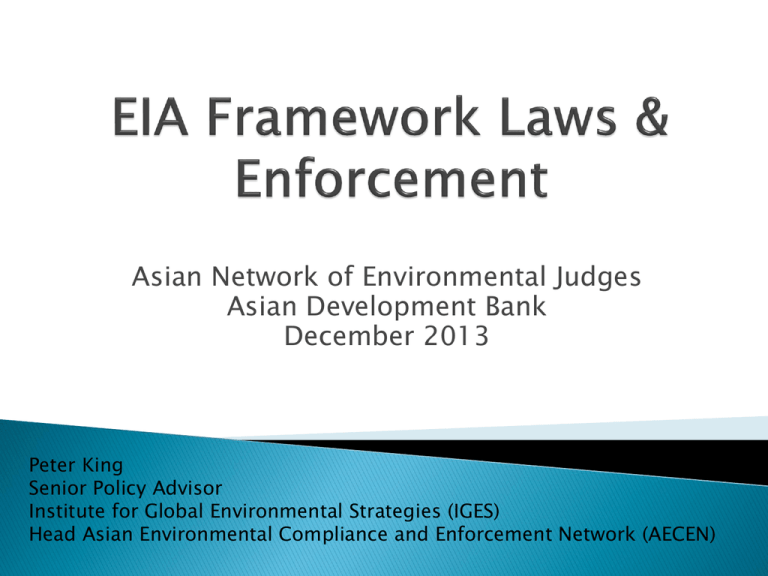
Asian Network of Environmental Judges Asian Development Bank December 2013 Peter King Senior Policy Advisor Institute for Global Environmental Strategies (IGES) Head Asian Environmental Compliance and Enforcement Network (AECEN) 1. Brief overview of impact assessments in: i. ii. iii. iv. v. vi. vii. 2. 3. 4. 5. United States Japan Malaysia China Korea Philippines EU (EIA Directive) Value of EIAs in an international context EIA related training Evaluation of EIA enforcement Concluding recommendations 1969 National Environmental Policy Act (NEPA): ◦ First legislation to provide a robust framework for addressing several environmental concerns simultaneously; ◦ EA/EIS process: The simpler EA usually has to be carried out within a 3-month time frame, and the more detailed EIS usually is required to complete within maximum 12 months (with exceptions). Proposing Agency EPA and other agency comments Public Comments Notice of Intent Scoping Process Final EIA Review and Approval Draft EIS Record of Decision (Stampe 2009) ◦ Purpose To decide whether a detailed environment impact statement (EIS) is necessary or not; To integrate generation and dissemination of environmental information; Foster collaboration among diverse public and private actors and stakeholders which characterize major, environmentally controversial decisions. Environmental assessment should be applied not only to project approval action but action on legislative and other such proposals (SEA), and EIS should be prepared by federal agencies. Number of EIS since 2004: 4,842 EIS is more cumbersome to produce than simple environment assessment; ◦ Key enforcement issue - is due procedure followed or are agencies trying to negate possible impacts to avoid EIS? EIA is required for 13 types of projects (MOEJ 2012:3) For class 1 projects, an EIA is mandatory, class 2 projects are optional, and the category “others” does not require EIA. Proposed projects are screened to determine whether EIA is required, and normally scale plays a large determining role in deciding on necessity of EIA. For class 2 projects, other factors such as location and proximity to environmentally and socially sensitive areas also play a role and decisions are made on a case-by-case basis (MOEJ 2012). Some amendments of Japanese EIA Law: Obligation to hold a public session at the stage of the assessment method determination; (earlier stage) as well as access to information on internet; Stipulation of the procedure to have opinions from Minister of the Environment in the selection of evaluation items; Stipulation of the procedure to gain advice from the Minister of the Environment when a prefectural governor etc. is the issuer of the license etc.; Enabling direct submission of opinion from the designated cities to the project proponent; Establishment of Primary Environmental Impact Consideration (PEIC) and Impact Mitigation Reporting (IMR); Key enforcement issue - moving from target clearance type of assessment to “best effort” type of assessment (for increased environmental performance). PEIC: alternative plans on a project location, scale and others are compared, and opinions of citizens, experts, local governments and others are considered in regard to possible impacts on living environment, natural environment and others caused by the project (class 1 mandatory/class 2 voluntary) ◦ Enables more earnest consideration of alternative plans before project is commenced, reducing subsequent compliance needs; IMR: After a project has been implemented, the proponent compiles and publishes a follow-up survey, along with the measures for protecting the environment to cope with the conditions identified during the survey and the progress of the measures taken. ◦ discloses the progress of the measures taken to the citizens who are interested, and complements the substance of measures taken by having opinions provided from the Minister of the Environment (DOE-MONRE 2010:20) Project Proponent No EIA Detailed EIA Preliminary EIA Screening and consultation with DOE No EIA Detailed assessment Preliminary assessment Preparation of Detailed Assessment Brief by review panel appointed by DOE Project proponent prepares TOR after informal consultation with DOE Preliminary assessment by project proponent Federal (or state) level review by DOE (Stærdahl, Jens, Zuriati Zakaria et. al 2004:5) Public Comments on Brief Preparation of Detailed Assessment by project proponent Public comments on report Approving Authority Report review by Review Panel Project implementation and monitoring Environmental Impact Assessment Order 1987 formally inscribed in 1988; Bodies responsible for EIA are the State Planning and Development Committee and the National Industrial Development Committee In Malaysia 19 project classes are required to undertake an EIA under the EIA Order 1987 EIA in Malaysia was a federal government responsibility, but since 1990s devolved to the states; EIA training of staff is a responsibility of employer/project initiator; Integration of Environmental Impact Assessment and Health Impact Assessment; Starting works without an EIA report raised to RM50,000 from RM20,000 (US$16,600); Establish specialized Environmental Court (jurisdictions include more than 38 environment-related laws such as Street, Drainage and Building Act, Local Government Act as well as 17 Regulations overseeing environmental quality). Mismatch of scale: 1987 EIA regulations are federal, but environmental issues are now under State jurisdiction; Participation ad-hoc: The form of public participation is left to the project proponent; Overlap: Integrated planning and EIA (often EIA is commissioned after State Executive Committee has already approved proposal); Implementation of the conditions in the EIA approval seems to be the weakest link in the Malaysian EIA system, suggesting more work for the Environmental Court. Environmental Impact Assessment Law of the P. R. China (adopted in 2003); ◦ EIA practice introduced in 1973 and implemented (project basis) since 1979; Rate of EIA enforcement for development projects was 61% in 1991 and it increased to 90% in 2000 (SEPA, 1999). EIA is supplemented by 15 specific laws that address air, noise and water pollution control, management of solid wastes, resource conservation, wildlife, landuse control, and hazardous material disposal. Important administrative regulations and guidance: the Ordinance of Environmental Management for Construction Projects (OEMCP) (1998); Also includes policies, plans or programs under the SEA law (not even all EU states have this); Monitoring is a compulsory part in China’s EIA process not only at completion of project but throughout implementation; Department of Supervision and Management under MEP is responsible for watching over and coordinating EIA implementation nationwide; EIA Review Committee is in charge of reviewing and making decisions on those EISs of projects that need the approval from MEP; Appraisal Center for Environment and Engineering: responsible for providing technical review, supporting research, and training for licensed agencies and sub-levels of Environmental Protection Bureaus (EPBs) (vertical integration); ◦ EPBs receive their budgetary resources from their local governments Three categories of projects (A, B, and C) (ADB) ◦ A: Projects which are likely to cause a range of significant adverse environmental impacts need to produce an Environmental Impact Report (EIR); ◦ B: Projects which are likely to cause a limited number of significant adverse environmental impacts need to fill in an Environmental Impact Form (EIF); ◦ C: No adverse impact expected but still have to fill in an Environmental Impact Form (EIF); 4 additional categories: (i) nuclear or military; (ii) cross-province; (iii) large scale and approved by State Council (more than US$2.5 million); and (iv) transboundary. Introduced in 1977; National Environmental Research Institute under the Office of the Prime Minister responsible for EIAs; 1982: professional EIA agencies (now around 200); 1990: Public participation; 1993: EIA Act (EIAA) (independent law); 1999: Introduction of SEA for administrative policies ◦ Preliminary Environmental Review System (PERS) 2009: Introduction of scoping process, simplified EIA, and inclusion of greenhouse gas emissions Number of EIA projects (2009): 76 unit projects / 17 areas MOE ROK and KEI are providing training on transboundary EIAs; Preparation of draft EIA Done by a qualified EIA agent Project developer Public participation Preparation of EIS Project developer Submission of EIS Project developer Approval agency Consultation of EIS Review of EIS by KEI Approval agency MOE Final Decision Approval agency project developer Monitoring Approval agency & MOE (Moon 2012) 2012: Now EIAs are no longer governed by both the Framework Act on Environmental Policy and the EIAA ◦ Eliminating confusion caused by inconsistencies in the Acts. Other amendments include: Strategic Environmental Impact Assessments and Small-Scale Environmental Impact Assessment replace Prior Environmental Review; ◦ Increase clarity and consistency Public opinions must be accepted at the SEIA stage Environmental Impact Evaluators certified through National Examination ◦ New criteria for experts broader and not only narrow technical expertise required; Environment Management Bureau (EMB) responsible for EIAs (both central and regional offices) some extent of decentralization; Emphasis on prevention (i.e. gather information prior to implementation to make informed decision about a project); Project proponent responsible for adequate training of staff; Category A. Environmentally Critical Projects (ECPs) with significant potential to cause negative environmental impacts Category B. Projects that are not categorized as ECPs, but which may cause negative environmental impacts because they are located in Environmentally Critical Areas (ECAs) Category C. Projects intended to directly enhance environmental quality or address existing environmental problems not falling under Category A or B. Category D. Projects unlikely to cause adverse environmental impacts. 1. 2. 3. 4. 5. 6. 7. Screening - determines whether the proposed project, requires an EIA and if it does, then the level of assessment required; Scoping - identifies the key issues and impacts that should be further investigated. This stage also defines the boundary and time limit of the study; Impact analysis - gathering of baseline information, and identifies and predicts the likely environmental and social impact of the proposed project and evaluates the significance; Mitigation - recommends the actions to reduce and avoid the potential adverse environmental consequences of development activities; Reporting - presents the result of EIA in a form of a report to the EMB; Review of EIA/Project Appraisal - examines the adequacy and effectiveness of the EIA report and provides the information necessary for decisionmaking; Project Implementation and Monitoring. This stage comes into play once the project is commissioned. It checks to ensure that the impacts of the project do not exceed the legal standards and implementation of the mitigation measures are in the manner as described in the EIA report. (University of Santo Tomas 2012) Introduced into EC law by a Directive (85/337/EEC) (adopted in July 1985); ◦ Distinguishes between Mandatory EIAs, and those at discretion of the Member States; “Best environmental policy consists of preventive action and that it is necessary to identify the likely damage to the environment of a particular project (or action) at the earliest possible stage” (Lambrechts, 1996). Policies Plans & programmes covered by SEA Directive (2001/42/EC) Projects covered by EIA Directive 85/337/EEC as amended by 97/11/EC and 2003/35/EC By July 2004 all EU Member States to implement SEA Directive; (EC 2006) 2 different versions of EIA - one is mandatory for all member states and the other is optional; ◦ Depending on classification of proposed projects (Annex I and Annex II respectively) Three important amendments ◦ 1997: Transboundary issues, more criteria, more information to be provided; ◦ 2003: Provisions for including Aarhus Convention objectives; ◦ 2009: Adding projects related to the transport, capture and storage of carbon dioxide (CO2); Bond 1999:4) (Moon 2012) Transboundary EIA treaties ensure that states give extraterritorial impacts the same scrutiny as domestic impacts. ◦ Transboundary development projects (rivers, estuaries, ecosystems, off-shore dredging, etc.); ◦ Coordination of ODA and development projects internationally; Transboundary regimes often lead to additional bilateral treaties between signatories; To improve efficacy of international EIA systems it would be necessary to either: ◦ Create matching international regulations analogous to the domestic ones that empower environmental ministries ◦ Ensure that member nations have EIA capacity at domestic level and transpose (and use) those institutions dealing with domestic EIAs for international ones. Capacity building and harmonization of EIA systems among countries; Twining partnerships among interested countries; What would be the best process for enforcement? • • Virtually all countries in Asia (and elsewhere) require EIA and this is generally embedded in national laws, regulations, and mandated procedures; Over time, developing countries have experimented with various innovations, such as cumulative assessments, health impact assessments, social impact assessments, and incorporation of climate change, but these innovations have not been adopted widely. http://www.aecen.org/eia-compendium Focus areas: (i) is the data generated effectively communicated to decision-making or planning processes; (ii) does the data and knowledge gained influence real outcomes. On the outcome side, criteria for evaluation pertain to two angles: (i) the emphasis on the outcomes and (ii) emphasis on soundness of the EIA process. In terms of bringing various stakeholders together, useful questions for evaluation of EIAs could focus on whether the EIA process provides any options for linking views and objectives of different stakeholders. (i) (ii) (iii) (iv) (v) (vi) (vii) (viii) (ix) Loopholes in the list of prescribed projects Late timing – decision has already been made to proceed Inadequate consideration of alternatives Incremental rather than cumulative impacts Conflicting interests - public sector projects are often the worst offenders for non-compliance Inadequate qualifications and certification Lack of data – especially cause-effect or doseresponse data Systematic under-estimation of costs Inadequate monitoring plans (x) Poor compliance and enforcement (xi) Inadequate sanctions +/or prosecutions (xii) Conflicting jurisdictions (xiii) Inadequate public participation (xiv) High transaction costs Note that a number of these challenges have more to do with effective implementation of EIAs and environmental monitoring and management plans, rather than their preparation. W ha t a re s o me o f the k e y le g a l a nd re g ula to ry limita tio ns to e ffe c tiv e imp le me nta tio n a nd e nfo rc e me nt o f E IA re q uire me nts in y o ur c o untry ? R e s p o ns e P e rc e nt R e s p o ns e Co unt 15.4% 2 23.1% 3 Inadequate EIA regulations do not provide clear guidelines on the conduct of EIA 23.1% 3 Laws do not impose enough accountability on developers and/or EIA consultants 38.5% 5 There are overlapping and/or conflicting jurisdictions of multiple agencies 30.8% 4 Sanctions are inadequate for violation (e.g. financial penalty is too small to act as a deterrent) 46.2% 6 Process is lengthy and cumbersome to acquire EIA approval 23.1% 3 23.1% 3 7.7% 1 Mechanisms are inadequate to monitor and enforce EIA regulations 53.8% 7 Other (please specify) 15.4% 2 List of prescribed projects are not sufficiently comprehensive or clearly defined EIAs are not legally required early enough in a project cycle EIA laws and regulations do not require effective public participation Guidelines are inadequate for EIA-approving authorities B a s e d o n y o ur e xp e rie nc e , wha t a re the k e y o b s ta c le s fo r the e ffe c tiv e imp le me nta tio n a nd mo nito ring o f E MMP s ? P le a s e s e le c t the thre e mo s t imp o rta nt re a s o ns . R e s p o ns e R e s p o ns e P e rc e nt Co unt 53.8% 7 30.8% 4 61.5% 8 Insufficient procedural guidance 30.8% 4 Lack of baseline data and no funding for data collection 23.1% 3 No sound basis/ expertise for proposed mitigation measures 23.1% 3 Proposed EMMPs are not cost-effective 23.1% 3 46.2% 6 Lack of ownership/commitment for EMMPs by project owner High transaction cost and inadequate funding in preparing the EIA Inadequate financing for monitoring EMMPs Inadequate sanctions (e.g. level of financial penalty is too low) General guidance materials for EIA practice are widely available, as noted in the bibliography (for example, Sadler and McCabe (2002) and UNU (2007), and in a number of countries government officers and professionals have received extensive training” (FAO 2009). Other countries (notably US) offer online EIA training courses, which makes it easier for officials and EIA staff at organisations to keep their knowledge up-to-date (EIA-training 2012). Also keep your eye on the AECEN EIA Compendium (http://www.aecen.org/eia-compendium) – more exciting developments to come. http://www.aecen.org/eia-compendium Environmental assessment should be implemented earlier (at program or policy formulation stage) to identify other alternatives at earliest stage before decisions are locked in; It could improve accountability if independent reviewers were to conduct the EIA review process; Compliance with EIA process/procedures at the approval stage, does not guarantee enforcement till the end of the project life-cycle. EIAs should include also possible longterm and decommissioning impacts. Consider moving from target clearance type of assessment to “best effort” types of assessment. “Best-effort” assessments may reveal more effective options than if minimal predefined and static targets were to be achieved. EIAs alone do not suffice. Environmental protection, standards and other regulations plus effective compliance and enforcement can increase environmental effectiveness when implemented alongside EIAs. - Aecen 2010. Environmental Impact Assessment (Eia) System in the Philippines. Strategic Environmental Assessment Considerations of Cumulative and Induced Impacts Financial Mechanisms.http://www.aecen.org/sites/default/files/workshop/june2010/ presentations/Presentation_sea,%20etc%20060910%20final.PHI.pdf ; -About Philippines 2013. Requirements for Environmental Impact Assessment System. http://aboutphilippines.ph/filer/PermittingProceduresEIA.pdf; - Bakar Jaafar 2004. Environmental impact assessment::principles, policy and practice. Abj Enviro-Lecture Series 1/2004. http://www.scribd.com/doc/29153105/ENVIRONMENTAL-IMPACT-ASSESSMENT-MSM3208-LECTURENOTES-7-Principles-Policy-and-Practice; -Bond A. 1999.EIA in the European Union. http://www.is.pw.edu.pl/plik/204/EIA%20in%20the%20EU.pdf - Chen Qiaoling, Yuanzhi Zhang and Ari Ekroos 2007. Comparison of China’s Environmental Impact Assessment (EIA) Law with the European Union (EU) EIA Directive. Environ Monit Assess (2007) 132:53–65 - Department of Environment – Ministry of Natural Resources and Environment of Malaysia 2010. Environmental Requirements: A Guide for Investors. Eleventh Edition. October 2010. http://www.doe.gov.my/portal/wpcontent/uploads/2010/12/A-Guide-For-Investors1.pdf -EC 2006. “Strategic” Environmental Assessment Directive 2001/42/EC: “on the assessment of the effects of certain plans and programmes on the environment”. Relationship with the Cohesion Policy for the period 2007-2013. Presentation. http://ec.europa.eu/environment/integration/pdf/nychas_en.ppt - EMB 2010. Technical Guidelines for the conduct of Environmental Impact Assessment (EIA) under the Philippine EIS System: Integrating Climate Change Risk Reduction (CRR)/ Climate Change Adaptation (CCA) Analysis emb.gov.ph/eia-new/2010-12/General%20Guidelines.pdf; - Hayes Sean 2013. Environmental Impact Statements in Korea: New Korean Environmental Impact Assessment Regime. The Korean Law Blog. http://www.thekoreanlawblog.com/2013/02/environmental-impact-statementsin.html Kersten, Charles M.2009. Rethinking Transboundary Environmental Impact Assessment. A Note. http://www.yale.edu/yjil/files_PDFs/vol34/Kersten.pdf; - Memon Ali 2002. Devolution of environmental regulation: EIA in Malaysia. Case study 6. UNEP EIA Training Resource Manual. http://www.unep.ch/etu/publications/13)%2045%20to%2061%20doc.pdf; - MOEJ 2012. Environmental Impact Assessment in Japan. Environmental Impact Assessment Division. Ministry of the Environment of Japan. http://www.env.go.jp/en/focus/docs/files/20120501-04.pdf; - MOEJ 2010. History of EIA Systems and Measures taken around the World. https://www.env.go.jp/earth/coop/coop/ document/10-eiae/10-eiae-2.pdf; - Moon, Nankyoung 2012. Environmental Impact Assessment system in Korea. Presentation. Geneva April. 24 , 2012. Korea Environment Institute. http://www.unece.org/fileadmin /DAM/env/eia/documents/ WG2.1_apr2012/EIA_system_ROK_moon_Geneva.pdf -Phillips, M.J., Enyuan, F., Gavine, F. et.al. 2009. Review of environmental impact assessment and monitoring in aquaculture in Asia-Pacific. In FAO. Environmental impact assessment and monitoring in aquaculture. FAO Fisheries and Aquaculture Technical Paper. No. 527. Rome, FAO. pp. 153–283. http://www.fao.org/docrep/012/i0970e/i0970e00.htm; - Stampe, John 2009. Lessons Learned from Environmental Impact Assessments: A Look at Two Widely Different Approaches – The USA and Thailand. The Journal of Transdisciplinary Environmental Studies vol. 8, no. 1, 2009. http://www.journal-tes.dk/vol_8_no_1/artiekl%202%20John%20Stampe.pdf - Stærdahl, Jens, Zuriati Zakaria et. al 2004. Environmental Impact Assessment in Malaysia, South Africa, Thailand, and Denmark: Background, layout, context, public participation and environmental scope. The Journal of Transdisciplinary Environmental Studies vol. 3, no. 1, 2004 http://www.journal-tes.dk/ vol%203%20no%201/Jens%20St%E6rdahl_lav.pdf?id=00028 University of Santo Thomas Undated. Environmental Impact Assessment in the Philippines. EnviArch SP2: Ecological Construction. http://xa.yimg.com/kq/groups/18629501/722933483/name/Environmental - Unknown 2012. 1st HIA for ASEAN Workshop. Understanding Health Impact Assessment (HIA): A Foundation for the Well-being of the ASEAN Community” 13-14 February 2012, The Aquamarine Resort and Villa, Phuket, Thailand; - Tao Tang, Zhu Tan and Xu He 2007. Integrating environment into land-use planning through strategic environmental assessment in China: Towards legal frameworks and operational procedures. Environmental Impact Assessment Review Volume 27, Issue 3, April 2007, Pages 243–265. http://www.sciencedirect.com/science/article/pii/S0195925506001247

